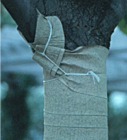Home > Planting trees > Establishing trees in the landscape > Trunk protection during establishment
Trunk protection during establishment
(Click on photos for more information)
Protection from rodents: Keeping mulch six or more inches from the base of the trunk can help discourage rodents from causing damage to the base of the trunk. Corrugated plastic protection tubes (sometimes called tree shelters) protect newly planted small tree seedlings from rodents, deer and sunscald.
Tree shelters can speed shoot growth of small seedling trees but some tree species develop weak trunks and small root systems and are unable to hold themselves erect (Kjelgren 1994; Burger et al. 1992). Trees can be enclosed in wire or mesh screening to keep out deer. Some horticulturists slice a 6 to 12-inch-long section of black plastic drain pipe so it can be slipped around the lower trunk. Others use plastic trunk guards which can be spiraled around the trunk and lower branches or other specially designed devices for trunk protection.
 Protection
from climatic extremes: Wraps tightly secured to the trunk provide little
buffering of climatic extremes, but they can provide some protection during
shipping (Appleton 1993). Burlap and plastic devices are occasionally used as
wraps.
Protection
from climatic extremes: Wraps tightly secured to the trunk provide little
buffering of climatic extremes, but they can provide some protection during
shipping (Appleton 1993). Burlap and plastic devices are occasionally used as
wraps.
The most commonly used material, paper wrap, does not buffer temperatures as presumed (Litzow and Pellet 1983). There is little research that has validated the practice of wrapping or spraying the trunk to prevent sunscald. Trunk wrap probably does little harm to the tree provided it remains intact in winter and is removed the following spring along with any tape and string used to tie it on the trunk.
Use biodegradable or photodegradable material if possible. Some protection from the direct sun can be provided by short, temporary branches left along the lower trunk of transplanted trees.
Sunscald on the south and southwest side of the
trunk of thin-barked trees has been attributed more to lack of soil moisture
following transplanting than to any other cause (Roppolo
and Miller 2001). Injury commonly described as sunscald can have a variety
of causes including trunk cracks resulting from improper pruning cuts, canker-forming
fungi, and boring insects. Preventing sunscald may be as simple as irrigating
regularly following planting and making appropriate pruning
cuts.
Protection from equipment: Trunk injury from equipment causes serious and lasting damage to trees. Regular weed control in an eight foot diameter circle around the trunk is the best way to protect the trunk of a recently planted tree. This will help ensure that equipment stays clear of the trunk.
Wood or metal stakes can serve to protect the tree from accidental injury from lawn maintenance equipment. Three or more stakes can be driven through the mulch layer into the ground several feet from the trunk. Do not attach them to the tree. Mowers can bump into the stake but not the tree. Thick, black plastic drain pipe slipped around the base of the trunk or other plastic devices are also used to provide some protection against string trimmers and mowers.

